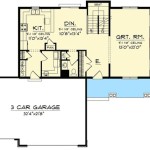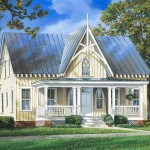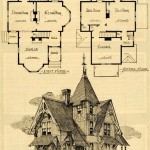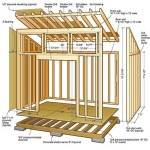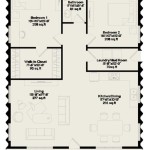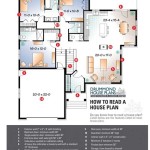A flat roof style house plan involves designing homes with a roof that has a minimal pitch, typically less than 10 degrees. These plans offer unique aesthetic and functional advantages, providing a sleek and modern architectural style. One common example of flat roof style house plans can be found in contemporary buildings such as art galleries and museums, where the flat roof serves as a functional platform for rooftop installations or green spaces.
The popularity of flat roof style house plans has been growing in recent years due to their clean lines, energy efficiency, and increased usable rooftop space. However, it’s important to consider factors such as drainage systems, maintenance requirements, and climate conditions when opting for a flat roof design.
In the following sections, we will delve into the characteristics, benefits, and considerations involved in flat roof style house plans, providing insights to help you make informed decisions about choosing this architectural style for your home.
Here are 10 important points to consider regarding flat roof style house plans:
- Modern aesthetic
- Functional rooftop space
- Energy efficiency
- Low maintenance
- Increased natural light
- Drainage considerations
- Structural support
- Climate suitability
- Rooftop access
- Cost implications
These factors can help you make an informed decision about whether a flat roof style house plan is the right choice for your needs.
Modern aesthetic
Flat roof style house plans offer a modern and sleek architectural style that is popular in contemporary architecture. The clean lines and minimalist design of flat roofs create a striking visual appeal that sets them apart from traditional pitched roof homes.
- Geometric forms: Flat roofs allow for the creation of geometric forms and sharp angles, giving homes a modern and cutting-edge look.
- Emphasis on horizontal lines: The absence of a sloping roof draws attention to the horizontal lines of the house, creating a sense of balance and proportion.
- Integration with outdoor spaces: Flat roofs can be extended to create terraces or balconies, seamlessly blending indoor and outdoor living areas.
- Contemporary materials: Flat roofs often incorporate modern materials such as metal, concrete, and glass, enhancing the home’s contemporary aesthetic.
The modern aesthetic of flat roof style house plans appeals to those who value clean lines, simplicity, and a touch of industrial chic in their homes.
Functional rooftop space
Flat roof style house plans offer the unique advantage of functional rooftop space, transforming the roof into a valuable and versatile outdoor area.
- Outdoor living: Flat roofs can be extended to create rooftop terraces or balconies, providing additional outdoor living space for relaxation, entertaining, or gardening.
- Green roofs: Flat roofs can be designed to incorporate green roofs, which are covered with vegetation and offer environmental benefits such as rainwater retention, insulation, and improved air quality.
- Rooftop gardens: With proper structural support, flat roofs can accommodate rooftop gardens, allowing homeowners to grow their own fruits, vegetables, and herbs.
- Solar panels: The large surface area of flat roofs makes them ideal for installing solar panels, generating renewable energy and reducing energy costs.
The functional rooftop space offered by flat roof style house plans adds value and versatility to homes, creating additional living areas, promoting sustainability, and providing opportunities for self-sufficiency.
Energy efficiency
Flat roof style house plans offer inherent energy efficiency advantages due to their unique design characteristics:
- Reduced heat loss: The compact form of flat roof homes minimizes the surface area exposed to the elements, reducing heat loss through the roof.
- Improved insulation: Flat roofs can be easily insulated to high levels, preventing heat transfer and maintaining a comfortable indoor temperature.
- Thermal mass: The concrete or metal materials commonly used in flat roofs have high thermal mass, which helps to regulate indoor temperatures by absorbing and releasing heat slowly.
- Solar energy potential: The large, unobstructed roof surface provides an ideal platform for installing solar panels, allowing homeowners to generate their own renewable energy and reduce their carbon footprint.
By incorporating these energy-efficient features, flat roof style house plans can significantly reduce energy consumption and utility costs while promoting sustainable living.
Low maintenance
Flat roof style house plans offer low maintenance advantages compared to traditional pitched roofs:
- Reduced risk of leaks: The absence of complex rooflines and valleys in flat roofs minimizes the potential for leaks, as there are fewer points of entry for water.
- Easy access for repairs: Flat roofs are easily accessible, making it convenient to inspect, clean, and repair any issues that may arise.
- Durable materials: Flat roofs are typically constructed using durable materials such as concrete, metal, or specialized membranes, which are designed to withstand weathering and require minimal maintenance.
- Reduced need for cleaning: The lack of steep slopes on flat roofs makes it less prone to accumulate dirt and debris, reducing the need for frequent cleaning.
The low maintenance requirements of flat roof style house plans save homeowners time, effort, and expenses associated with roof maintenance, providing long-term cost savings and peace of mind.
In addition to the above, flat roofs can also be designed with built-in drainage systems that efficiently channel rainwater away from the roof surface, reducing the risk of water damage and further minimizing maintenance needs.
Overall, flat roof style house plans offer a low-maintenance roofing solution that is both practical and cost-effective, freeing up homeowners’ time and resources for other aspects of their lives.
Increased natural light
Flat roof style house plans offer opportunities to maximize natural light, creating bright and airy living spaces:
- Large windows and skylights: Flat roofs allow for the installation of large windows and skylights, which flood the home with natural light, reducing the need for artificial lighting.
- Reflective surfaces: The flat roof surface can be designed to incorporate reflective materials, such as white paint or metal, which bounce sunlight into the home, further enhancing natural illumination.
- Open floor plans: Flat roof homes often feature open floor plans, which allow natural light to penetrate deep into the home, creating a sense of spaciousness and reducing the need for separate lighting zones.
- Atriums and courtyards: Some flat roof designs incorporate atriums or courtyards, which are enclosed spaces with glazed roofs, allowing natural light to reach the interior of the home.
The increased natural light in flat roof style house plans not only reduces energy consumption and promotes sustainable living but also creates a healthy and invigorating living environment, boosting mood and overall well-being.
Drainage considerations
Flat roof style house plans require careful attention to drainage to prevent water accumulation and potential damage to the roof structure and interior of the home.
The primary drainage system for flat roofs involves the use of scuppers or drains. Scuppers are openings in the roof’s perimeter that allow water to flow directly to the ground. Drains, on the other hand, are typically located at low points on the roof and are connected to downspouts that channel water away from the building.
The number and size of scuppers or drains required depend on the size and slope of the roof. Proper spacing and sizing are crucial to ensure efficient drainage and prevent water pooling. Additionally, the drainage system should be designed to handle the volume of water generated during heavy rainfall.
Internal drainage systems may also be incorporated into flat roof designs. These systems involve collecting water from the roof surface into concealed gutters or channels and directing it to downspouts located within the building. Internal drainage systems offer a cleaner and more aesthetically pleasing appearance but require more complex design and installation.
To further enhance drainage, flat roofs can be designed with a slight slope or camber. This slope helps direct water towards the drainage outlets and prevents ponding. The slope should be gradual to avoid affecting the overall aesthetics of the roof.
Proper drainage considerations are essential to ensure the longevity and integrity of flat roof style house plans. By carefully planning and implementing effective drainage systems, homeowners can minimize the risk of water damage and maintain a healthy and safe living environment.
Structural support
Flat roof style house plans require careful consideration of structural support to ensure the stability and integrity of the roof. Unlike traditional pitched roofs, which rely on gravity to shed water, flat roofs must be able to withstand the weight of water accumulation, as well as other loads such as wind and snow.
The structural support system for a flat roof typically consists of a combination of beams, joists, and decking. Beams are the main load-bearing elements that span the width of the roof and support the joists. Joists are smaller beams that run perpendicular to the beams and provide support for the decking. The decking is the surface layer of the roof, which is typically made of plywood or concrete.
The spacing and size of the beams, joists, and decking are determined by the size of the roof and the anticipated loads. In areas with heavy snow or wind loads, the structural support system must be reinforced to withstand the additional weight and pressure.
In addition to the primary structural support system, flat roofs may also incorporate secondary support elements such as purlins and girts. Purlins are horizontal members that run parallel to the beams and provide additional support for the joists. Girts are vertical members that run perpendicular to the purlins and help to stabilize the decking.
Proper structural support is crucial for the safety and longevity of flat roof style house plans. By carefully designing and constructing the structural support system, architects and engineers can ensure that the roof is able to withstand the various loads it will encounter, providing a safe and stable living environment for the occupants.
Climate suitability
The suitability of flat roof style house plans is influenced by the climate of the region where the home will be built. Flat roofs perform well in climates with minimal precipitation and mild temperatures, as they are less prone to leaks and damage caused by heavy rain or snow.
In areas with heavy rainfall, flat roofs require careful attention to drainage and waterproofing to prevent water accumulation and potential leaks. Proper drainage systems, such as scuppers or drains, must be installed to efficiently channel water away from the roof surface.
Flat roofs in cold climates need to be designed to withstand snow loads. The structural support system must be reinforced to support the weight of snow and prevent collapse. Additionally, the roof surface should be sloped slightly to promote snow shedding and minimize the risk of ice dams.
In areas with high winds, flat roofs require proper anchoring and detailing to prevent uplift and damage. The roof structure must be securely attached to the walls and foundation, and wind-resistant materials should be used for the roof covering.
By carefully considering the climate conditions and incorporating appropriate design features, flat roof style house plans can be successfully implemented in a variety of climates, providing homeowners with a modern and functional living space.
Rooftop access
Flat roof style house plans often incorporate rooftop access, providing homeowners with a unique and versatile outdoor space. Rooftop access can be achieved through various design elements, each offering its own advantages and considerations.
One common method of rooftop access is through an internal staircase or ladder leading directly to the roof. This provides a convenient and secure way to access the rooftop from within the home, making it easy to enjoy the outdoor space without having to go outside. Internal rooftop access is particularly beneficial for homes in urban areas or with limited outdoor space, as it allows homeowners to maximize their available space.
Another option for rooftop access is through an external staircase or ladder located on the exterior of the home. This type of access is often used for larger homes or those with multiple stories. External rooftop access provides a more direct route to the roof but may require additional safety features, such as railings or a safety harness, to ensure safe ascent and descent.
In some flat roof house plans, rooftop access is integrated with outdoor living areas, such as terraces or balconies. These spaces are designed to seamlessly connect the indoor and outdoor environments, allowing homeowners to extend their living space onto the roof. Rooftop terraces and balconies offer a private and secluded outdoor retreat, perfect for relaxation, entertainment, or simply enjoying the views.
Cost implications
Flat roof style house plans can have different cost implications compared to traditional pitched roof designs. Understanding these cost factors is essential for homeowners considering a flat roof for their home.
The cost of a flat roof is influenced by several factors, including the size of the roof, the materials used, and the complexity of the design. Flat roofs generally require more materials and labor to construct compared to pitched roofs, as they involve creating a level surface and installing a waterproof membrane.
The choice of roofing materials also impacts the cost. Flat roofs can be constructed using a variety of materials, such as asphalt, metal, concrete, or specialized membranes. Each material has its own unique properties and cost considerations. For example, metal roofs are more expensive than asphalt shingles, but they offer greater durability and longevity.
The complexity of the flat roof design can also affect the cost. Roofs with complex shapes or multiple levels may require additional materials and labor, increasing the overall cost.
In addition to the initial construction costs, flat roofs may also have ongoing maintenance costs. Regular inspections and occasional repairs are necessary to ensure the roof remains waterproof and in good condition. The frequency and cost of maintenance depend on the materials used and the climate conditions.










Related Posts

